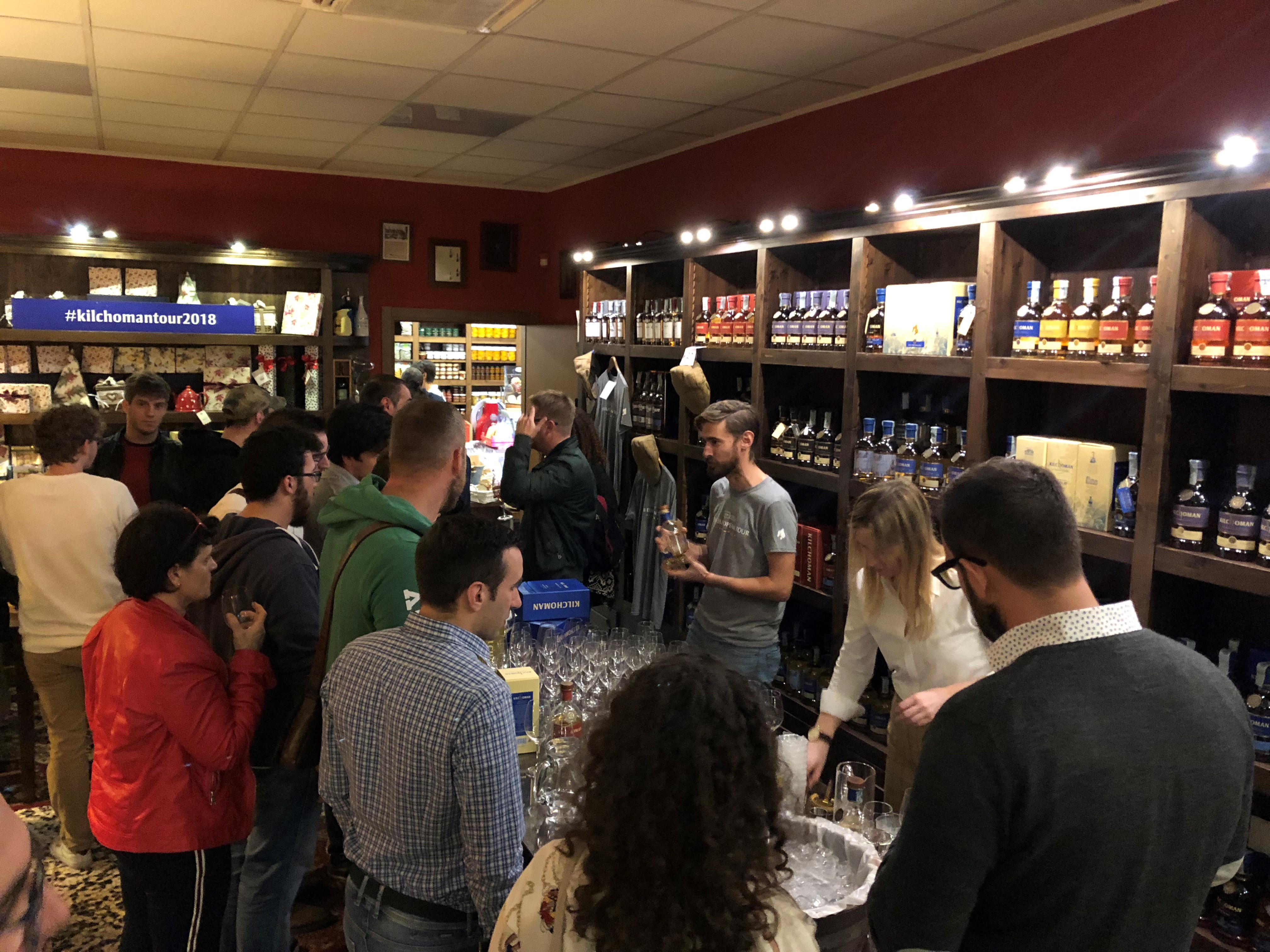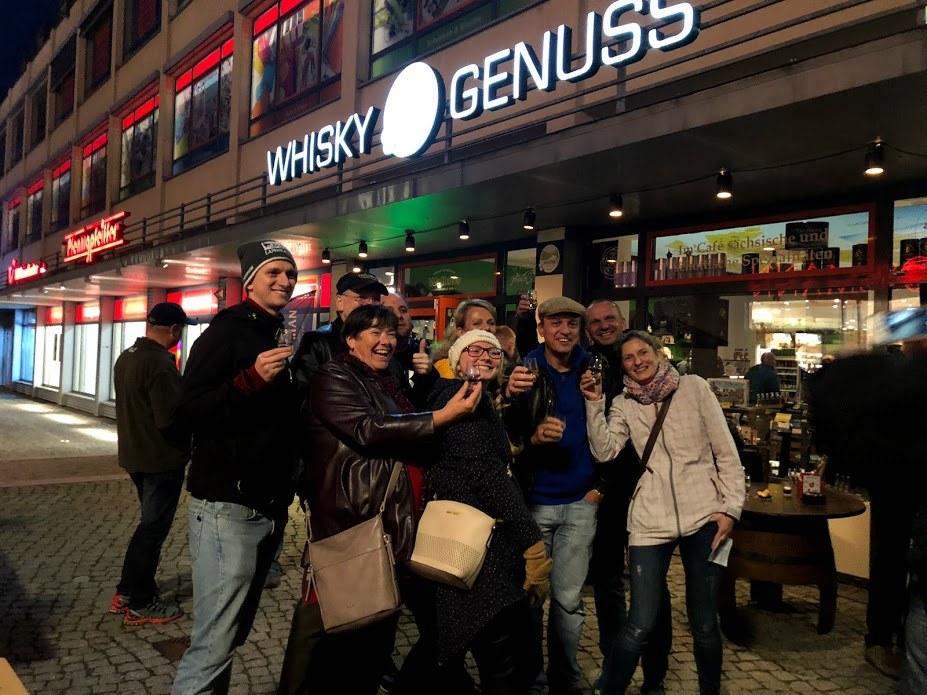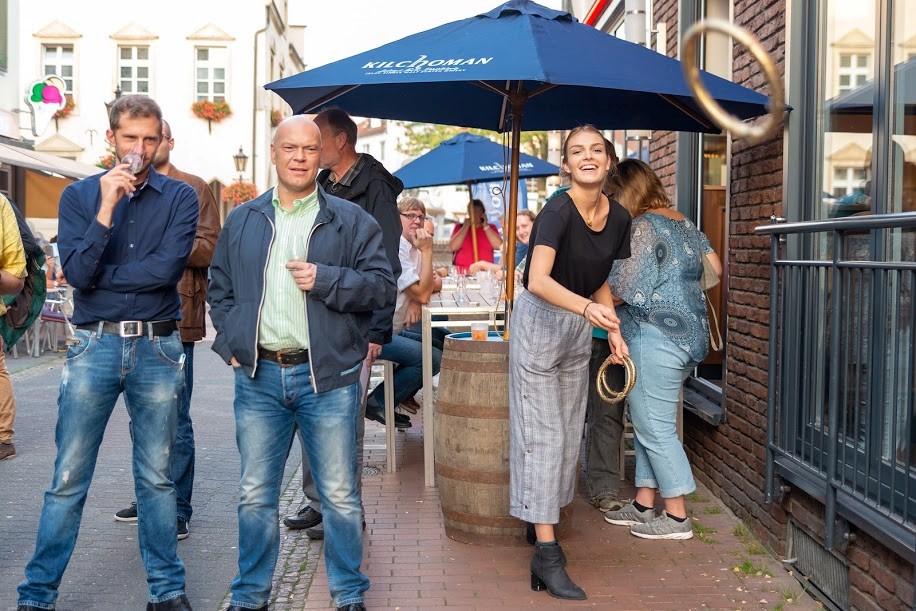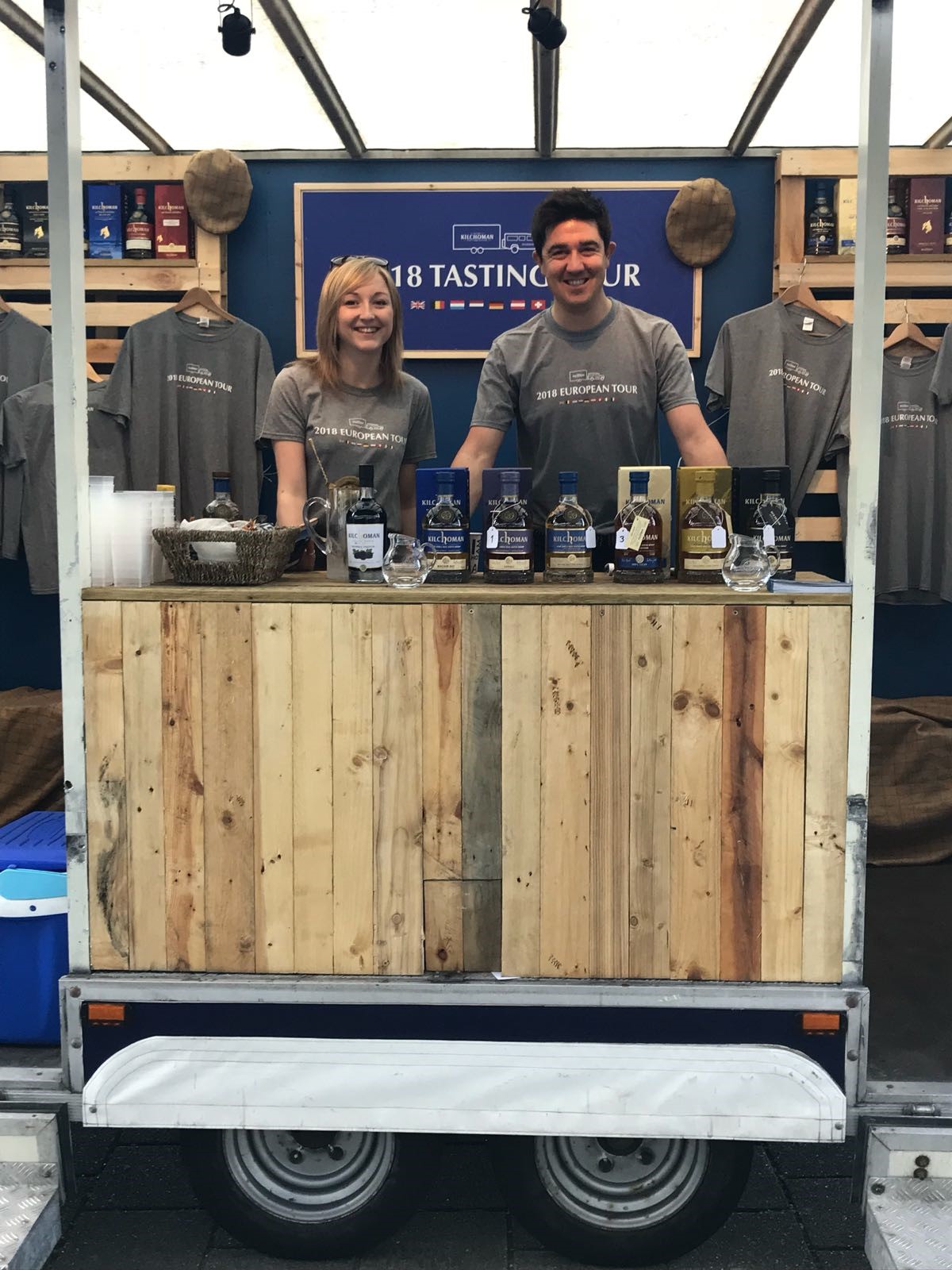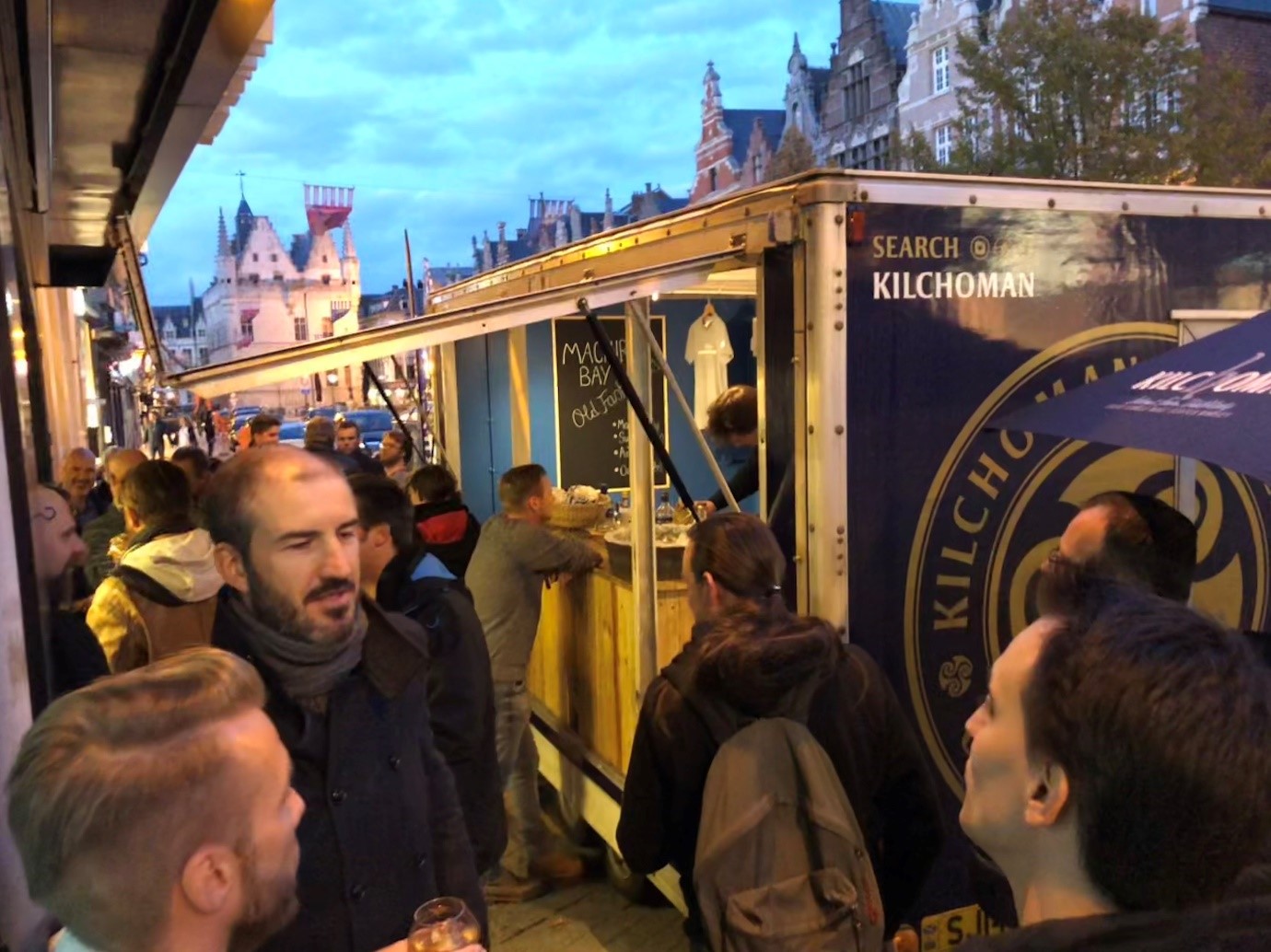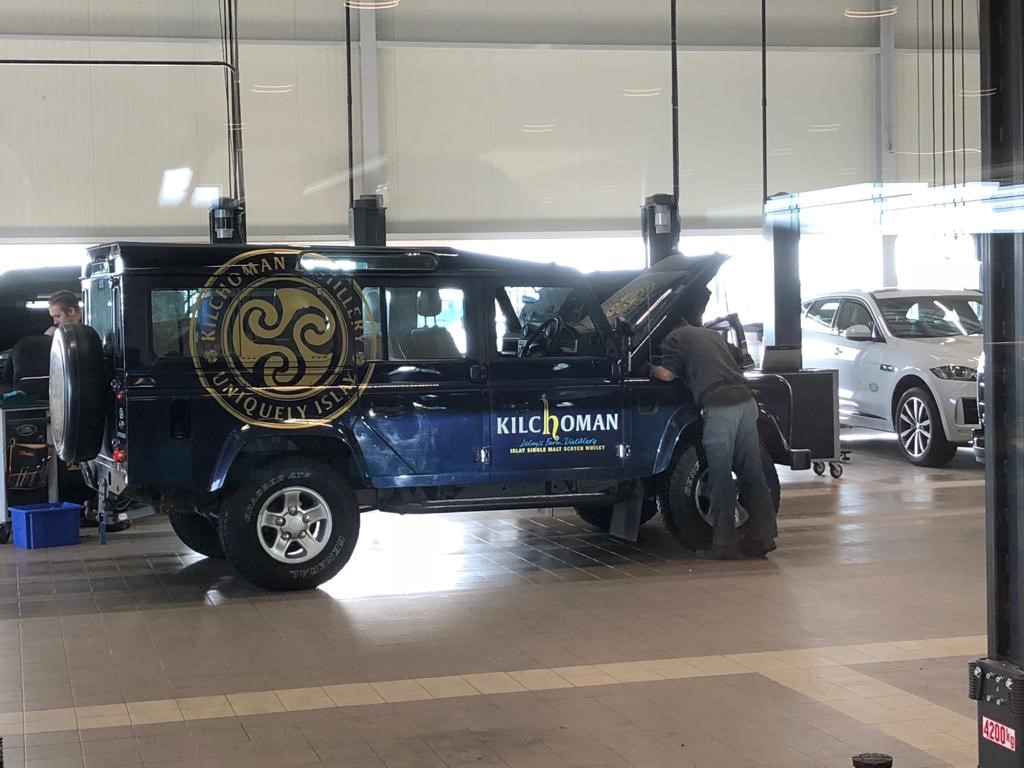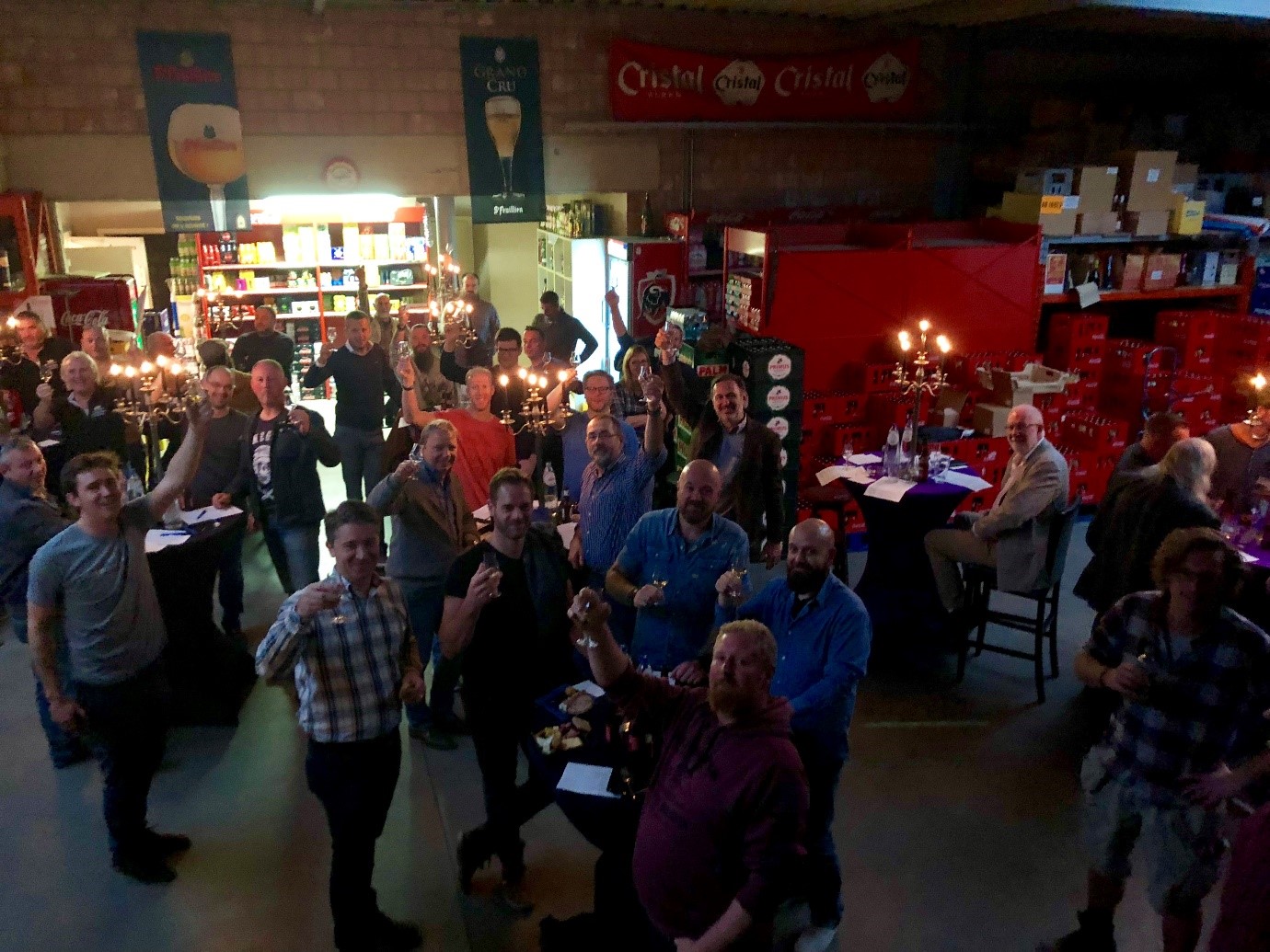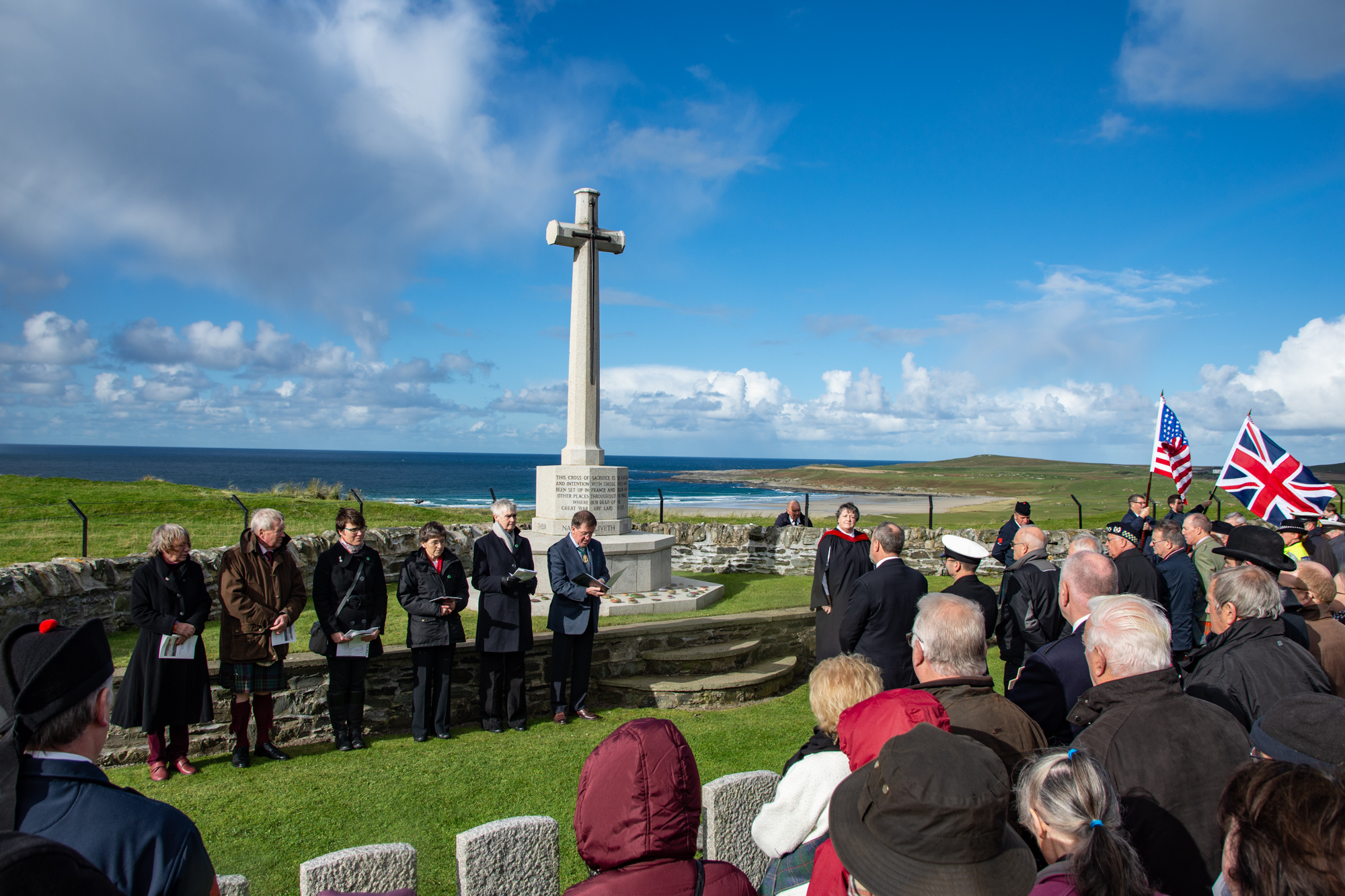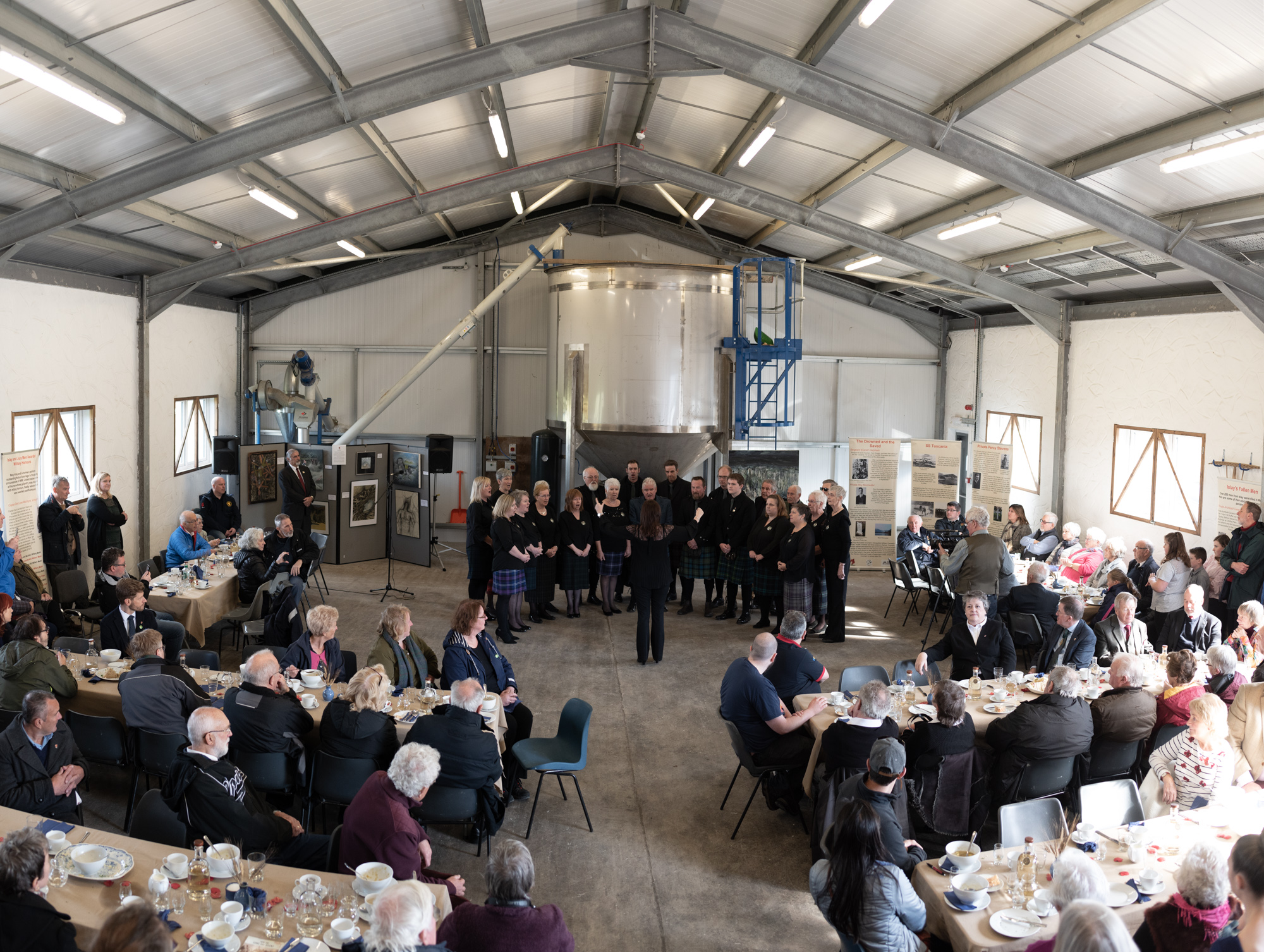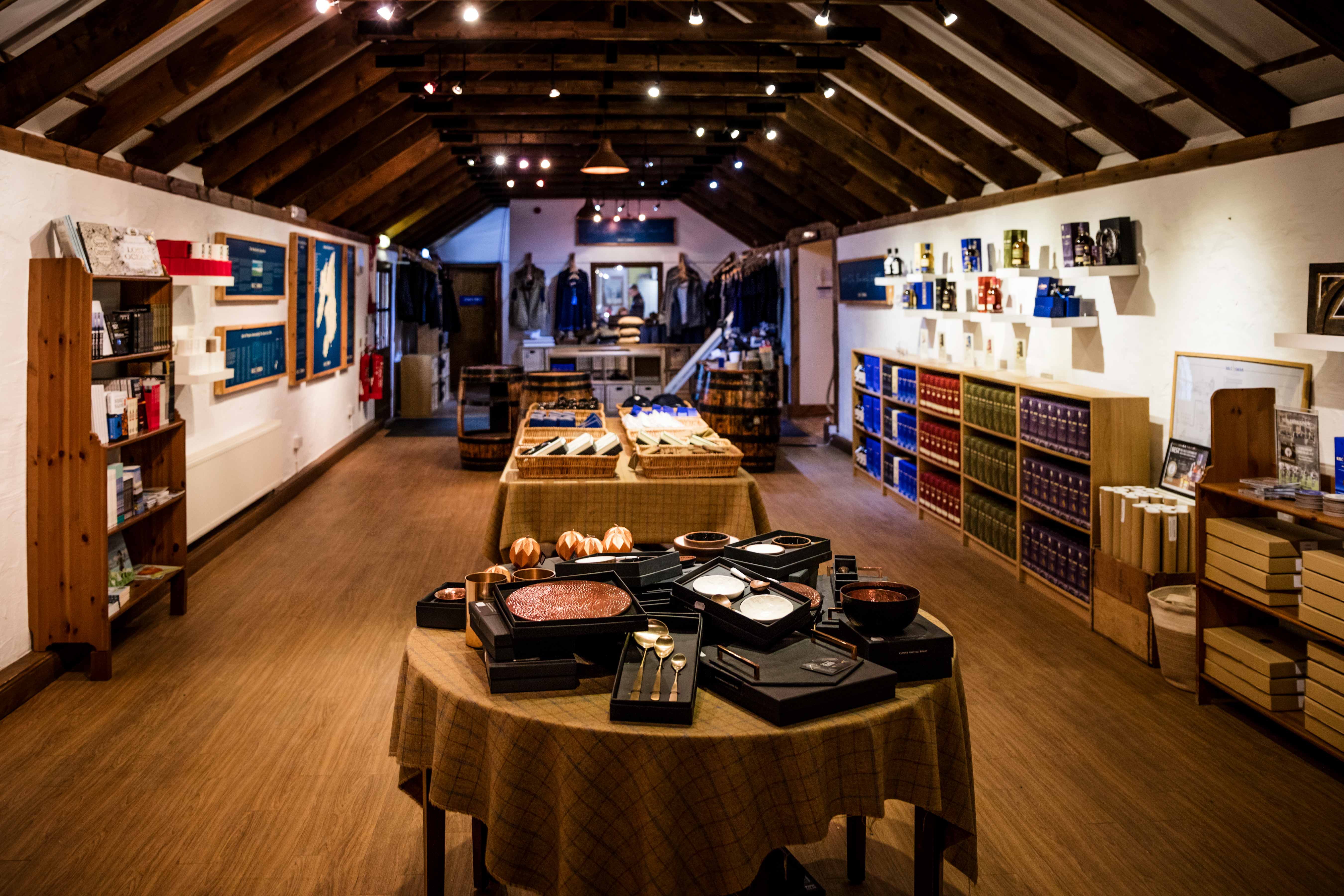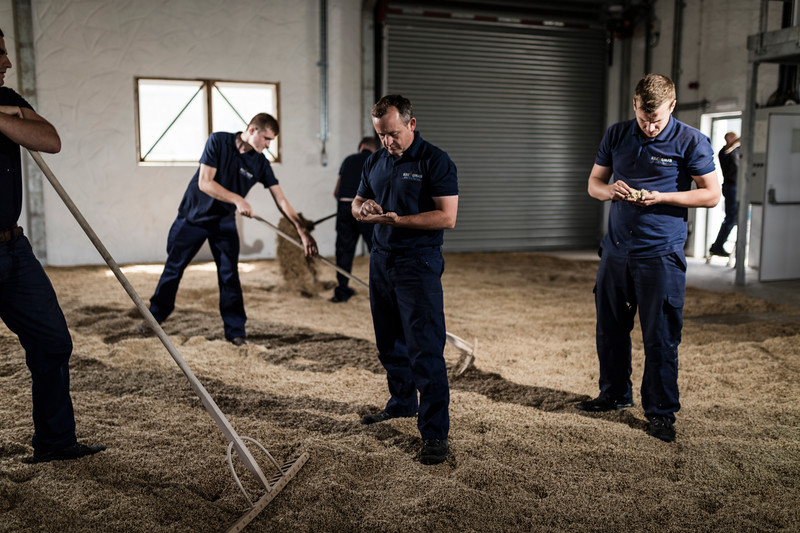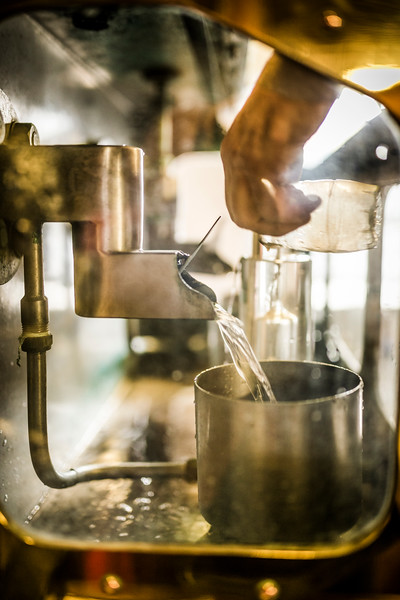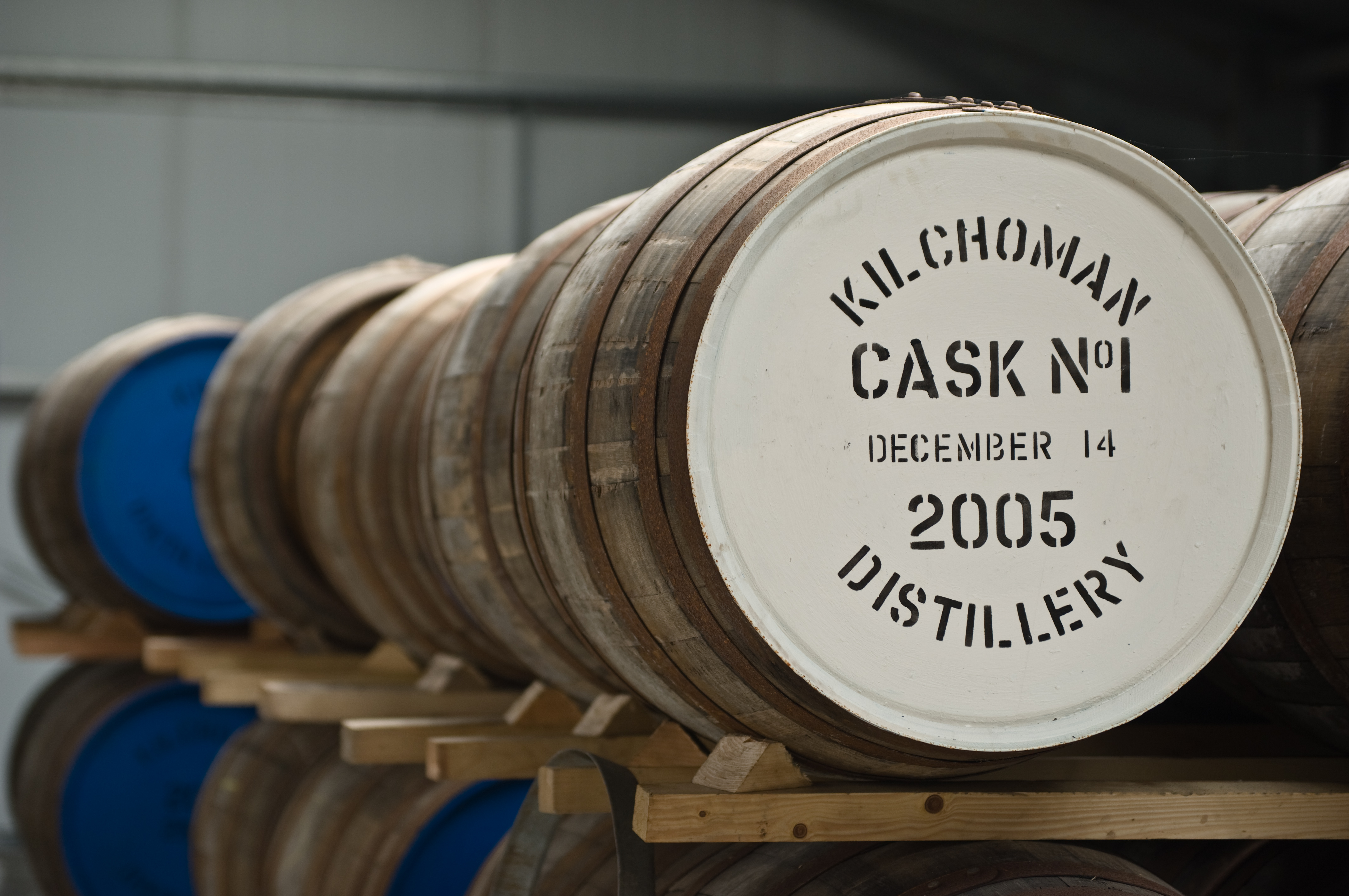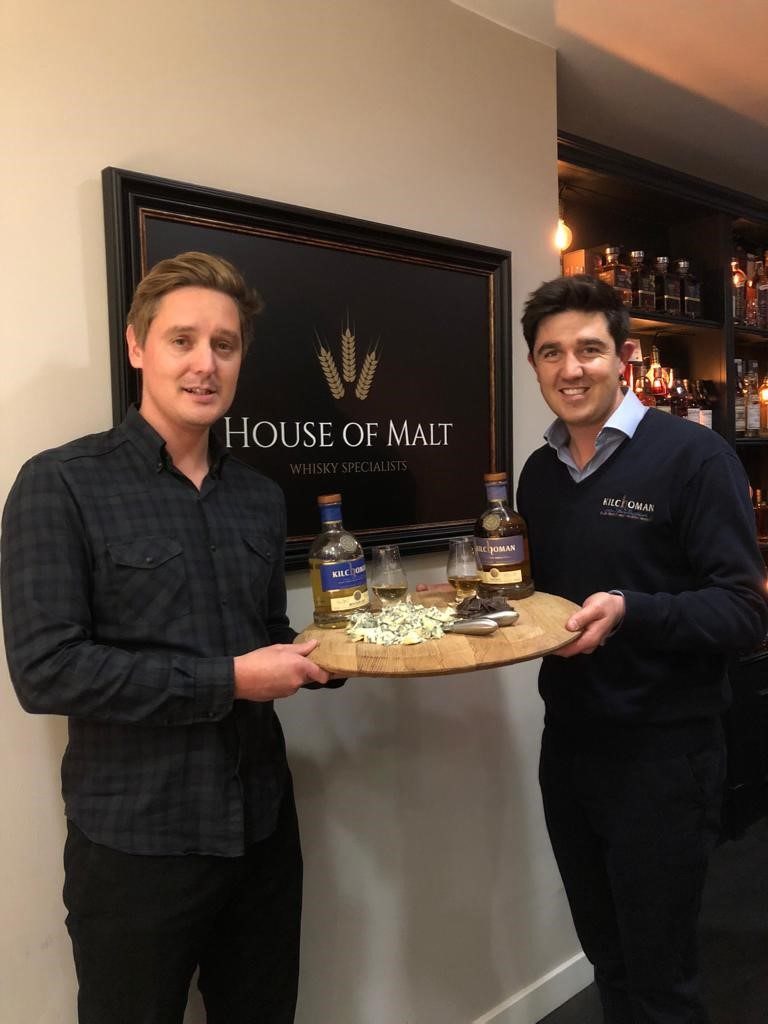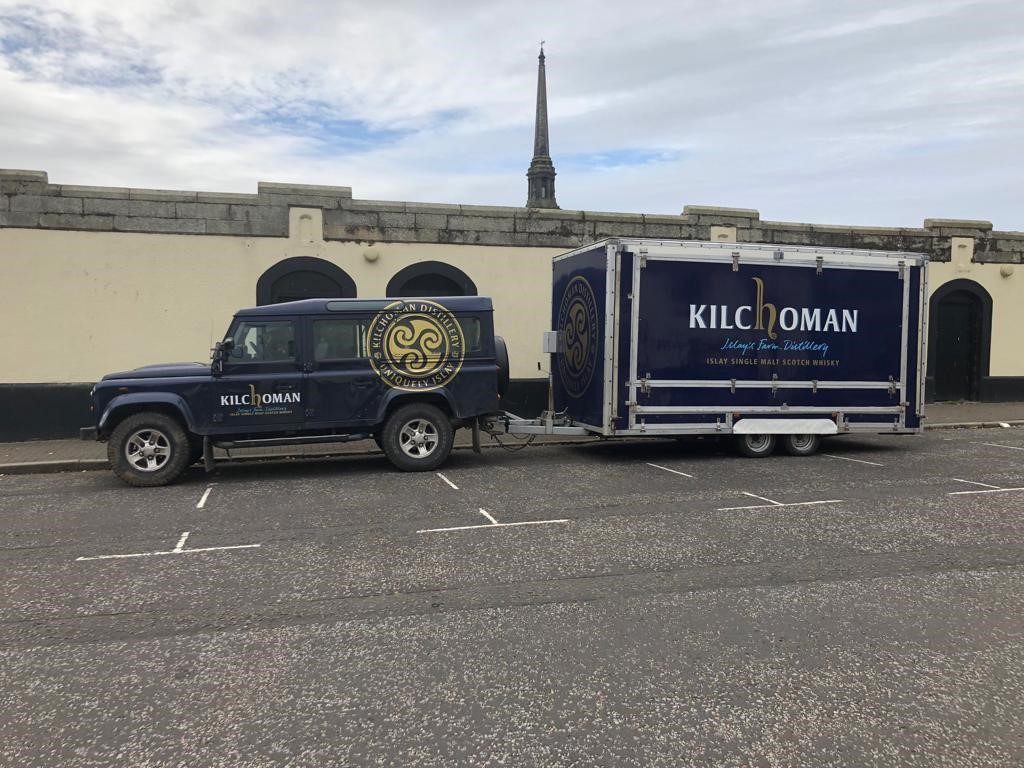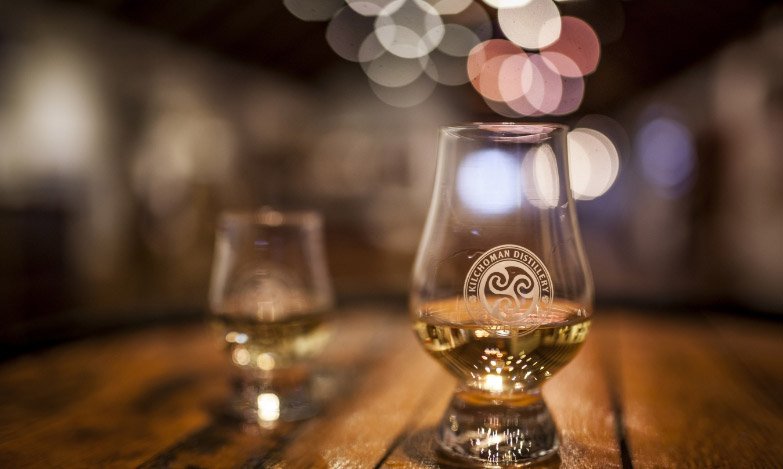We finished a great week in Germany before Olivia flew back home for a rest and Peter hopped in the Land Rover to start the long drive from Dresden to Vienna. The drive took him through the Czech Republic and unfortunately only Peter made it out the other side and into Austria, the Land Rover and trailer did not! There was a bit of an accident and the car and trailer still remain in a garage in Brno, Czech Republic, but we’re happy to report everyone was ok and only the Land Rover was damaged.
We made a quick swap in Brno and the Kilchoman Land Rover and Trailer became the Kilchoman hired transit van…. Peter is covering his face with embarrassment rather than any injury!
Peter packed up the van with all the whisky, flags, t-shirts, casks and a whole lot more before heading down to meet Russell in Vienna. He was busy serving up the Machir Bay Tour Release to the fine folk at the Falstaff Bar and Spirits Festival and later that night had an event with Pot Still and Reingruber. Dr Bottle in Graz was the second and final stop in Austria where before heading over the mountains to Italy.
Peter and Russell (and the transit van) made it to Blend Bar in Castelfranco for their first event in Italy and it was great to be at one of our Kilchoman Comraich bars for the evening. There was a whisky club tasting in one room and flights of Kilchoman coming from the bar, along with an array of expertly made cocktails from the team at Blend. Next it was off to Harp Pub in Milan and Vini e Piu in Cantu where over 100 people turned out in torrential rain to enjoy some drams at the last stop in Italy.
James and Nicole were up next for the drive up and over the Alps.
As with any new venture it’s sometimes difficult to know just where to start. Do you go for the cheapest bottle you can find and work your way up or dive straight into a single cask limited release? Fortunately, Kilchoman single malt is the perfect choice for getting into scotch whisky, especially if you’re looking for something unique and complex, with heritage ingredients and traditional practices. It’s initially easy going and accessible, but it reveals new layers of character with every sip.
That said, there’s a few ways to help you make the most of the true Kilchoman experience…
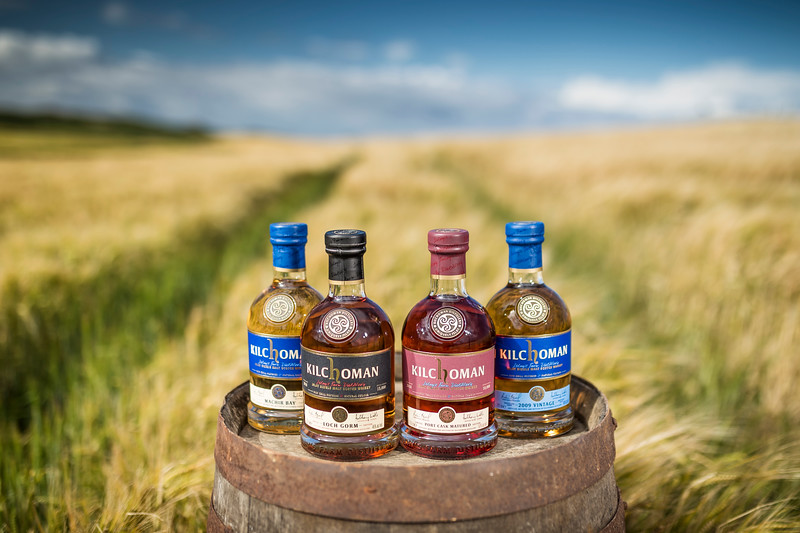
Step one: Prepare
Kilchoman is a reflection of the island that produces it: slow going, thoughtful and best visited more than once. With this in mind, it’s worth taking a little bit of time to truly enjoy the moment – the more comfortable you are, the better. After all, you want the whisky to take center stage. Part of this is getting your favourite tumbler or Glencairn glass and delicately pouring just a dram into its shiny embrace. Take a moment to appreciate the colour. It may seem like a small thing, but the golden sheen of a Machir Bay speaks for its overall character: crisp, light and refined.
Kilchoman is best served neat, unspoiled by mixers. However, this is an individual choice and there are certainly some fine Kilchoman cocktails to be found, just ask those sampling the Machir Bay Old Fashioned on the European Tour. Alternatively, you can add a small drop of water – a process that releases some of the aromatics and flavour hidden inside. It’s also wise to cleanse your palate first. After all, it’s difficult to appreciate the subtlety of a good dram with the remains of an Islay Venison Burger stuck between your teeth!
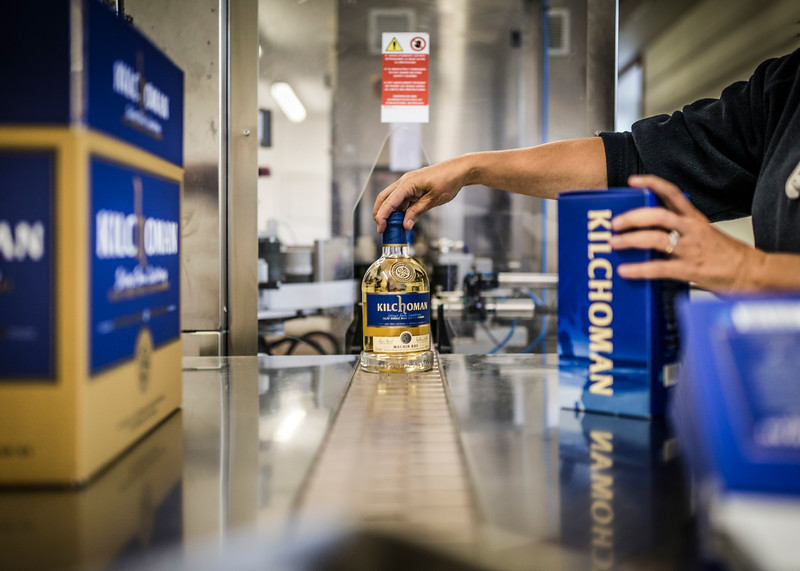
Step two: Nose
First thing is first, before you take a sip, you must nose your dram of Kilchoman – A few swirls will help to unlock the aromas in your Kilchoman: notes of citrus zests, vanilla biscuit and ever changing layers of peat smoke will make themselves apparent initially. However, don’t worry if you smell something different, the human nose can detect over 30,000 different scents and you may well pick up on other qualities first. Some have reported hints of nuttiness, honey and the oddly specific ‘salted white chocolate’; just remember though, there is no right or wrong. Each experience is subjective and each sampling will reveal further depth for you. If you catch a subtle hint of Chilean shrubbery or a passing whiff of burnt rubber, that’s just your experience!
Try and make a mental note of each aroma that lifts from the glass. When it comes to tasting, it’ll help you pick out individual flavours from the sip. Start with your nose about an inch from the rim of the glass and gently inhale, noticing the lighter delicate aromas that rise up first. If your nose begins to burn, take a step back and inhale less strongly. If you pass out, unfortunately you’ve clearly forgotten to breathe back out.
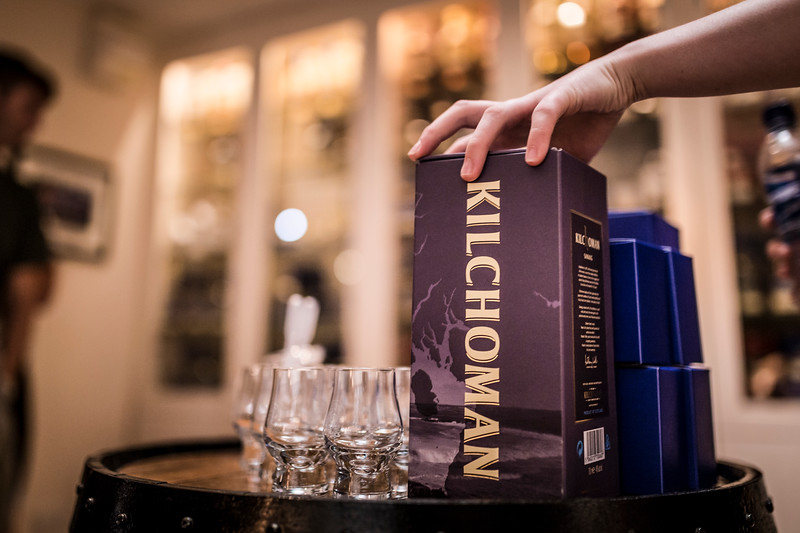
Step three: the taste
With the memory of the aromas still fresh in your mind, give the glass another swirl and slowly take a small sip, just enough to coat your tongue. Let it swirl around your mouth, using the whole tongue to sample the flavour. Different areas have different sensitivities to certain tastes, so the tip may reveal different secrets to the back or sides.
This taste is what’s known as the palate, which is the main course to the whisky experience – the nose being the appetizer and the finish being the dessert that leaves you perfectly satisfied. The palate of Machir Bay has been described by one guest to the distillery as “a generous burst of tropical fruit and raisin, followed by playful layers of wafting smoke”. Again, there’s no right or wrong here, and if your taste buds tell you that the smoke flavours are ‘drifting’ instead of ‘wafting’, and the layers ‘thoughtful’ instead of ‘playful’, who are we to judge? The joy of whisky lies in your experience, and as far as we’re concerned, every opinion is equally valid on the shores of Islay.
As mentioned, the final flourish is the finish. It’s the taste that follows you long after the whisky has become acquainted with your esophagus. One of the things that makes Kilchoman the perfect introduction to scotch whisky is the fact that its finish is a remarkably clean one. This means none of the alcoholic burn associated with some whiskies is present. Look out for hints of peat smoke and plenty of mixed fruits that characterise the Kilchoman range… it should feel like nothing short of a warm hug!
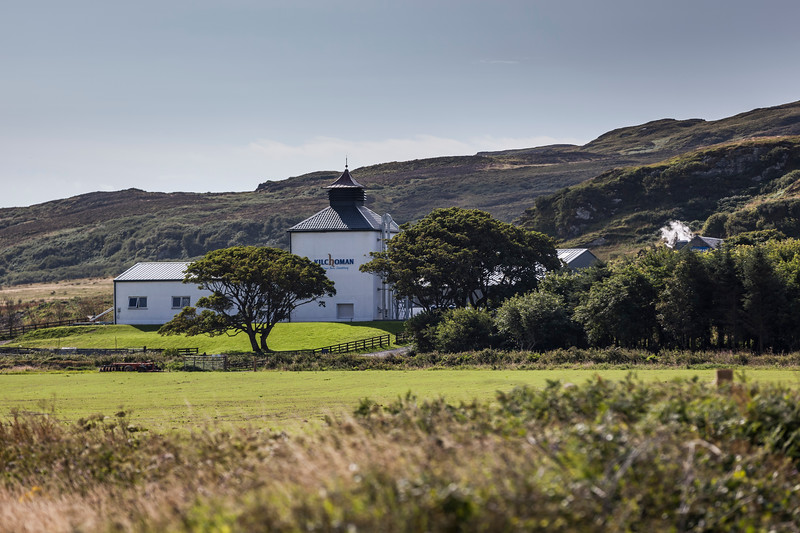
Step four: look photogenic
Like an Olympic gymnast nailing a perfect routine, it’s vital that you perfect your landing. Slowly lower your glass onto a coaster of your choice, exhale then look up and wink at anyone else in the room. They’ll know you’ve just sampled a Kilchoman. They’ll know you’re on the right track.
If in doubt you can always ask our founder, Anthony Wills, he’s an old hand at drinking whisky these days…

The week through Germany got us to about half way on the European Tour 2018, and boy what a crazy few week. We have now crossed Germany stopping in Bremerhaven, Lohne, Haltern am See, Fulda, Leipzig and Dresden!
Although the Land Rover is a fantastic companion, the hilly autobahn proved to be a struggle towing our heavy load, only reaching 50 kilometres per hour up some hills as the German drivers wooshed past! But we made it to all our events, welcomed by smiling, happy whisky lovers… and the Kilchoman Land Rover’s branded friend accompanied us throughout Germany!
The Ring-a-Dram is proving to be great fun causing some competitiveness to arise after a few drams, raising money for our partner The Sandpiper Trust, providing medical supplies to remote islands like Islay. (To learn more about The Sandpiper Trust visit: http://www.sandpipertrust.org).
We were even lucky enough to have some bagpipes join us, adding the final Scottish touch to some of our stops on the way.
Once again, we would like to thank all the shops who hosted us in Germany and all the helping hands who make the tour the success it is and of course thank you to all the people who joined us for a dram from all over Germany!
After George and JJ collected the Land Rover from some very helpful mechanics at Terlouw Land Rover they could start the Netherlands leg of the tour which took us to all corners of the country. We made 6 enjoyable stops in Wageningen, Musselkanaal, Eindhoven, Pijnacker, Spakenburg and Ijmuiden. Thank you to all the venues who made us feel so welcome and put on great events.
JJ, who’s day to day roll at the distillery is looking after the precious Kilchoman malt and watching over production in the still house, was enjoying turning his hand to making our Machir Bay Old Fashioned and telling tales of Islay to the Kilchoman fans in The Netherlands. JJ however wasn’t always the best navigator, at one point looking the wrong way at a roundabout and commenting ‘aye, all looks good’, luckily George looked the correct way (the left!).
It is often said that life is about the journey, not the destination. At Kilchoman, however, we must respectfully disagree with this saying. You see, when the destination is Kilchoman Distillery, Isle of Islay, the journey doesn’t matter so much: the important thing is the way you feel when you step foot onto the island knowing a dram is in the distance…
There’s just one minor question… how do you get there? First thing is first, to be able to visit Kilchoman you must find your way to Islay…
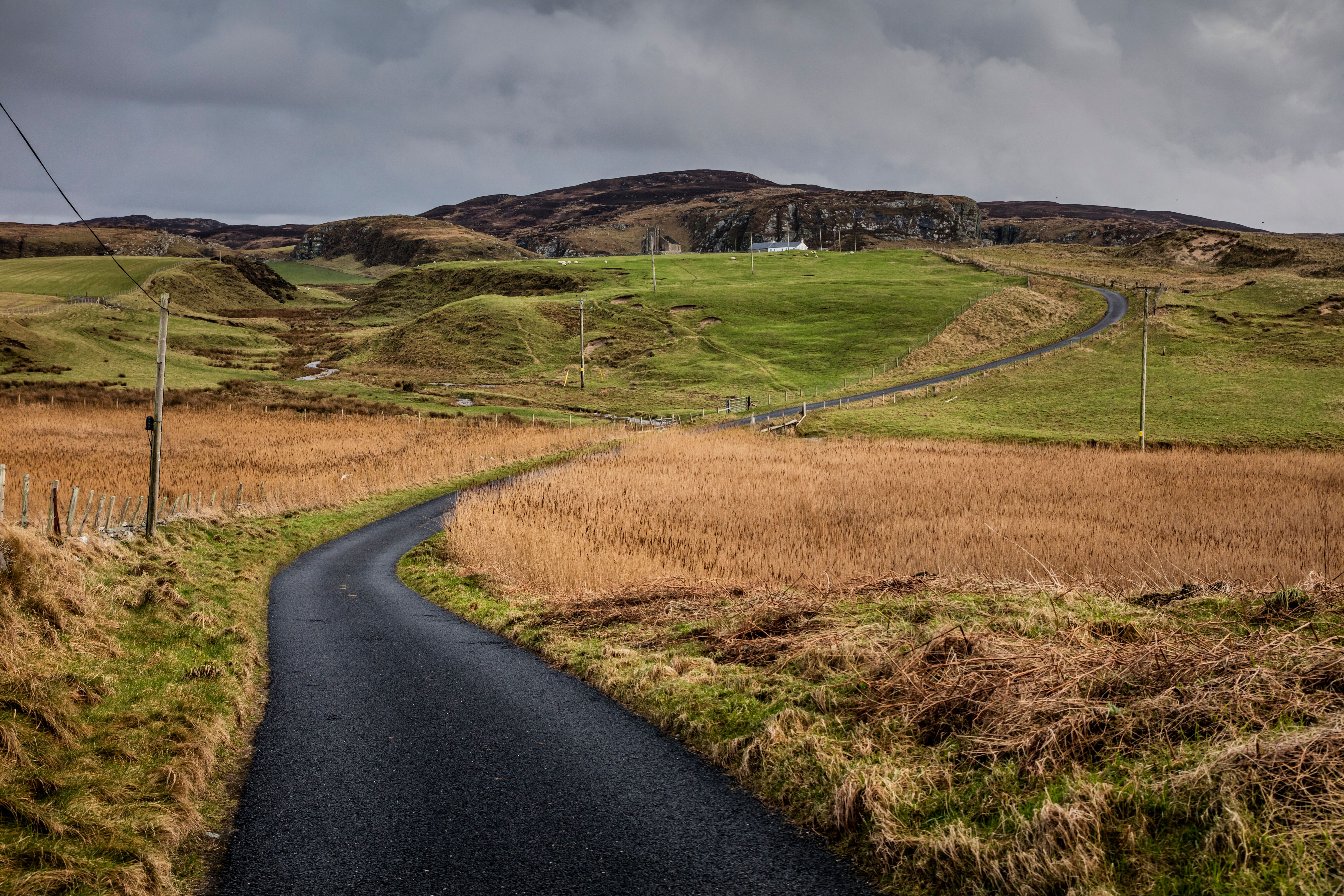
The sky…
For those who enjoy the feeling of flight, freedom (and some extra legroom), there’s no better option than to hop on a plane and enjoy the stunning view of Islay from above. At present time, flights run twice daily from Glasgow airport, meaning that you only have to wait 45 minutes before being able to step onto Islay and sample the rejuvenating sea breeze that rolls across its rugged landscape. Flights will also be available from Edinburgh to Islay from the spring in 2019. During the flight you can not only see Islay, but you will pass over Arran and (if you’re lucky) you will see the majestic paps of Jura. Understandably, these flights tend to get booked up pretty quickly, so it’s worth booking well in advance if you’re planning to drop in from the skies. Oh, and don’t forget to leave some room in your luggage for a bottle of whisky or two…

The salty sea…
In our humble opinion, there’s no more fitting experience than watching Islay’s rocky peaks fade into view while stood on the deck of a traditional ferry – the drama of this approach only adds to the mystic and historic appeal of an Islay distillery holiday. If you fancy yourself as more of a seafarer than a plane goer, then jump aboard the regular ferry service departing daily from Kennacraig. For those without a car, the easiest way of reaching it is via a three-hour coach service from Glasgow. Arching up through the Trossachs national park, stopping off at Inveraray for a hot chocolate or an ice cream cone taking this scenic route isn’t the worst way to spend a morning…
Vehicle reservations are possible on the aforementioned ferry, however there is limited space. So again, it’s worth booking well in advance. No matter where you are in the UK, the journey should be fairly straightforward. If you’re determined to stick to the mainland you’ll find that most routes pass through Glasgow, easily reachable within eight hours from London (via the M6), six hours from Cardiff and just over three hours from Manchester.
Alternatively, for those who love exploring, it’s possible to go on an island-hopping adventure, warming up by taking in the stunning landscapes of Arran and Kintyre on the way. The first step is to ferry transfer from Ardrossen to Brodick, enjoying its 19th century castle before driving north to the suspiciously Italian sounding port of Lochranzia. Another ferry will drop you at Claonaig on the western shores of the Kintyre peninsula, where you can finally drive eastwards to Kennacraig. Although Google will tell you that this route is shorter, don’t be fooled – you’ll have time to kill waiting for ferries. Don’t panic though, each port town is steeped in centuries of unique history and tradition, giving you plenty to do.
…Via less epic rails
Unfortunately (or maybe luckily) trains haven’t reached the unspoiled shores of Islay quite yet. While we wait for the inevitable eurostar Islay expansion, your best bet is to get a high speed link to Glasgow or head to Oban then grab a coach to Kennacraig.
A good walk (or a trek) …
It turns out that walking from London to Islay takes 1 million steps (give or take). In other words, it only takes six days of your time and some reasonable footwear! It wouldn’t be the most time-saving journey, but you would definitely deserve a dram of Kilchoman when you arrived!
We kid, of course, the point is that no matter which way you get to Islay, the journey will always be worth it. Whether you’ve skydived in or emerged from the icy waters wearing nothing but speedos, hitched a lift with an Ileach or simply taken the bus, the sweet taste of Kilchoman’s award winning single-malt is guaranteed to restore warmth to your weary travelers’ bones.
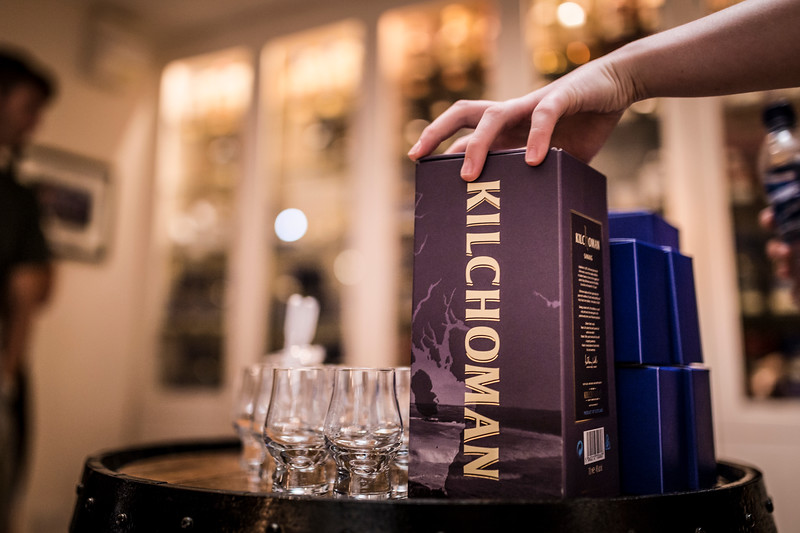
Once on Islay…
Now you have arrived on Islay, how do you find Kilchoman Distillery? It is a little off the beaten track but undeniably will be worth the wait, the trick of the trade is to have transport arranged, whether that be a hire car or a taxi (the Islay bus service does not stretch far enough to Kilchoman’s rural residence). Once in the car follow the single-track road (via google maps) and you will soon reach your destination. Around 40 minutes from each ferry terminal (and airport) you will be sipping on a dram of Machir Bay in no time! If you do manage to get lost along the way, the locals will be on hand to point the way!
With loch Gorm on your right hand side and Sanaigmore in the distance you know you’re on the right track to Kilchoman, a bit of a bumpy ride along the farm road, passing our golden barley fields, flocks of sheep and herd of cows you can park the car, breath in that fresh Islay air and enjoy your time with us at Kilchoman, we are so happy to have you here… Slainte!
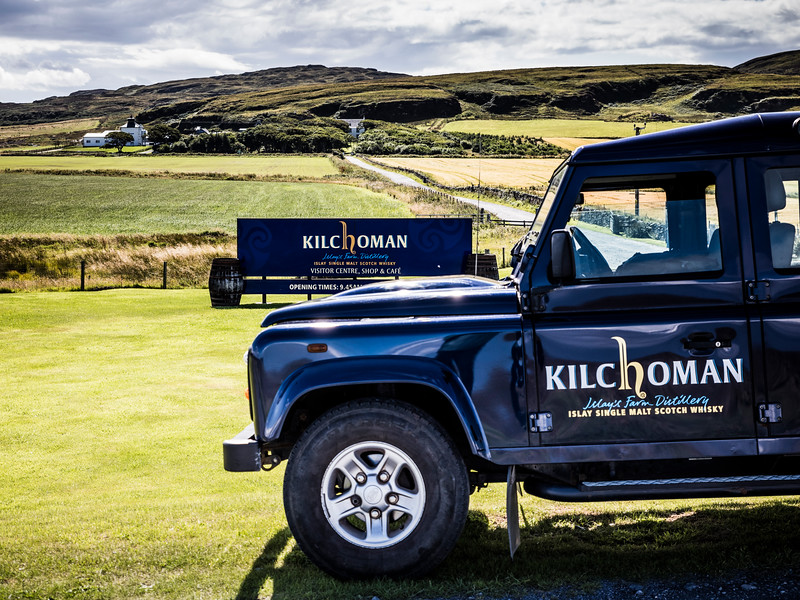
On a Friday evening after a busy week at work, is there anything better than settling down in front of the fire with a large dram of your favourite Kilchoman in hand. But have you ever thought in that moment, what makes this dram of Kilchoman special and distinct? One of the reason for this are the ingredients that go into making the whisky aswell as the unique method in which it’s done.
Barley
All single malts are created from malted barley. Here at Kilchoman we have two separate barley sources; over 200 tons is grown on the farm at the distillery and distilled exclusively for the 100% Islay range, the balance is shipped to Islay from the mainland forming the base ingredient for our core range; Machir Bay, Sanaig and Batch Strength as well as most of our limited editions.
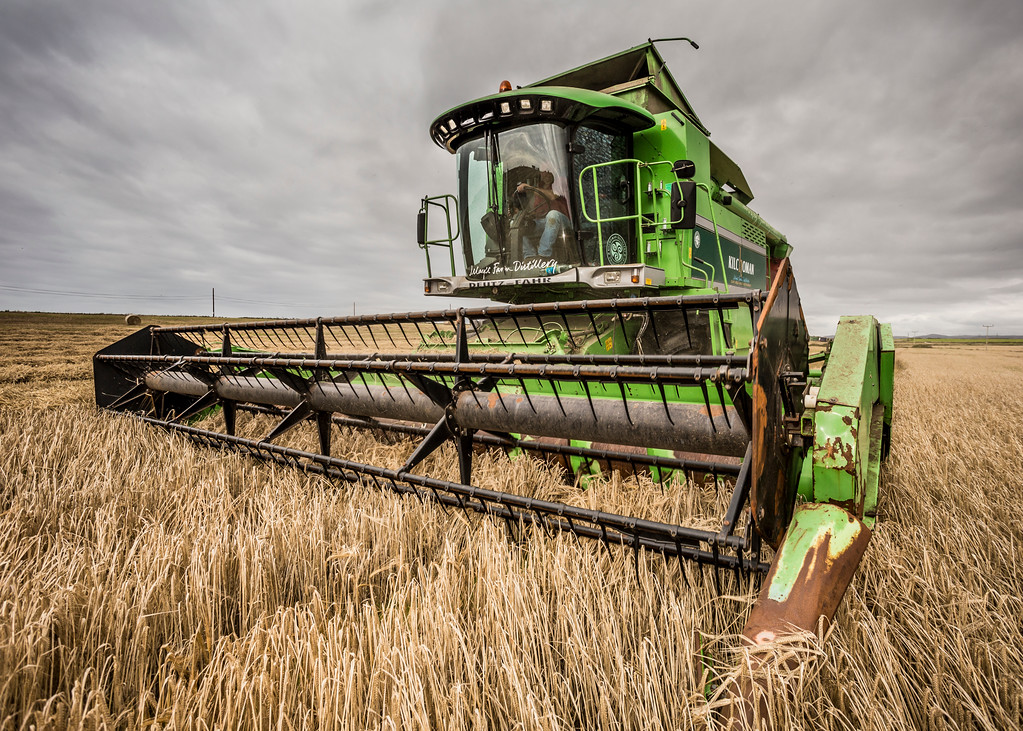
Growing conditions here at Kilchoman are drastically different to that of mainland Scotland. Whilst our soil is excellent quality, the stormy weather and salty atmosphere create a uniquely challenging environment affecting both the characteristics of the barley and the character of our 100% Islay whisky.
It is easy to see why many of Islay’s distillers have turned to mainland grown barley in place of local growers. The low rainfall and settled conditions of the east coast make growing high yielding barley significantly easier. The grains are noticeably larger than those grown on Islay, allowing distilleries to produce 5-10% more whisky per ton compared to Islay barley, like that grown at the distillery.
This year we’ve sown two varieties of barley here at Kilchoman, Concerto and Octavia. The barley made a good start, enjoying long periods of sunny weather broken up nicely by the odd days rain however just as we thought we might have a record harvest the weather turned and a period of wet and windy weather made harvesting a long and challenging process for Andrew and is team.
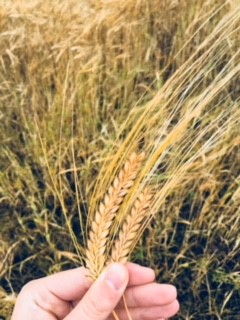
From left to right – Concerto and Octavia
Water
We draw our water from the Allt Gleann Osamail burn. Fed by a series of springs the water runs off the hills and collects in peat bogs of the Osamail glen just north of the distillery. The peat moss acting as a giant sponge, soaking up the water in winter and drip feeding the burn during drier summer months to ensure we are rarely short of water. The water picks up the distinct dark colour of the peat, resembling black tea. It is soft and pure with particularly low alkaline levels, perfect for distillation.
Peat
Islay Peat is special, and Kilchoman, though the newest distillery on Islay, we are arguably the most traditional in our scale and approach. Growing our own barley is part of this philosophy, however equally important is using Islay peat to smoke our barley. Islay is more exposed to the elements than mainland Scotland. The climate, ocean, wind and rain all have an effect on the island, therefore the peat and the whisky made from Islay peated barley is unlike any other; more salty, maritime and medicinal than mainland peated whiskies.
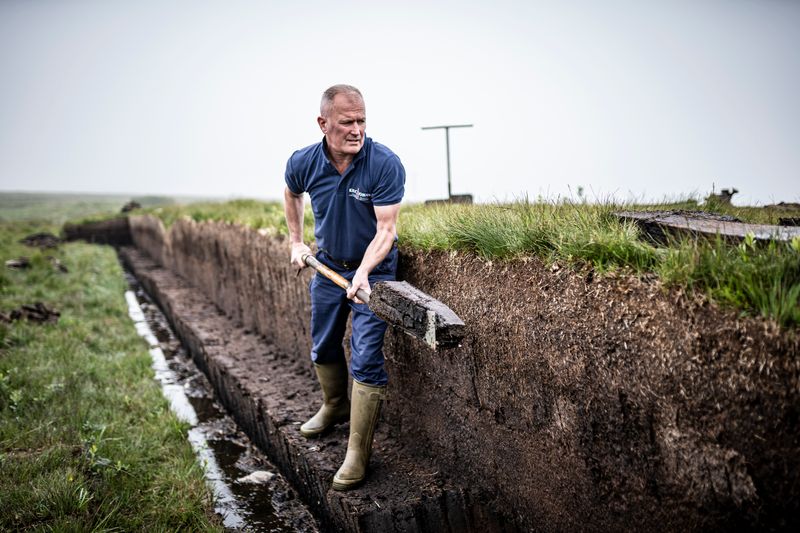
Each week when our green malt has germinated, it is taken to the kiln where it is peated over a 10-hour period. The green malt will lie above the peat fire in the kiln on a perforated floor and peat smoke will gently peculate through the grating imparting that special Islay flavour. Once spread, the door is shut, the fire is lit and we let clouds of smoke build up through the kiln and impart it’s characteristics into our barley. We will use around 80 – 100kg of peat per week and we mix the dried peat, with damp peat that we keep in barrels of water, this avoids our kiln becoming a fire and allows the maltmen to ensure that we are getting as much smoke as possible into the barley. When we light the kiln, we are looking for lots of peat smoke, not flames (as we found out the hard way in 2006!).
Yeast
Yeast is the fourth and final ingredient and it constitutes an essential part of the fermentation process. What exactly does yeast do? Once the mash has been ground down and the barley starch converted into fermentable sugar, the resulting liquid is something called ‘wort’. The wort is then pumped into a washback, and yeast is added. For every mash we create 6,000 liters of wort and we add 20kg of yeast to convert the sugars into alcohol. Every mash at Kilchoman is fermented for an average of almost 90 hours and the resulting alcoholic product is called ‘wash’, at around 8%abv.
There are different kinds of yeast that can be used in the production of single malt scotch: distillers’ yeast, brewer’s yeast, wild yeast, or a combination of each are suitable for scotch. We use Mauri Distillers Yeast during the fermentation process. While it may be more subtle than other elements of production, yeast certainly influences the overall flavour of a scotch whisky as different yeasts breed in different ways, thus influencing its chemical makeup and accentuating certain flavours. Generally speaking, distilleries will use yeasts that can cope with both high temperatures and high amounts of sugar, as well as those which do not clump together during fermentation.
The Method
Not only do we have our four main literal ingredients that are needed to make a Kilchoman dram, there are values that we follow, live and work by that have a huge part to play in our final product – Traditional methods in a traditional location, Hard Work, Dedication and Patience
Kilchoman Distillery was the first distillery to open on Islay in over 124 years and is a family run traditional farming distillery. Anthony Wills, our founder, made the decision to open a new distillery on this well-known whisky isle, this was driven by his passion to go back to the grass roots of whisky making. Producing whisky that had been made completing all parts of the process from barley to bottling on site.
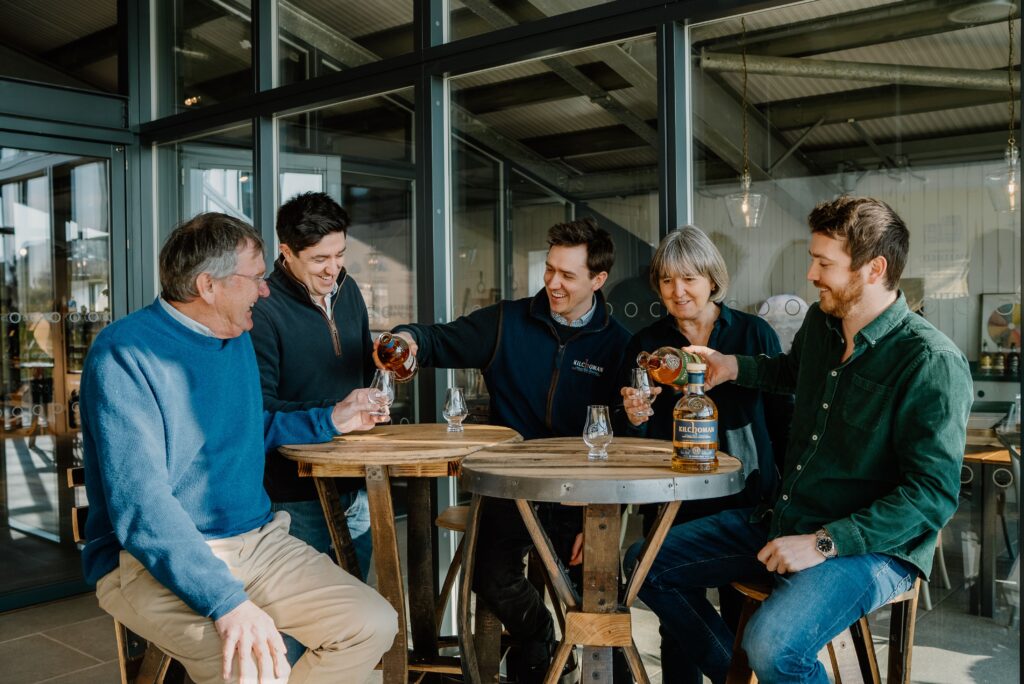
Anthony & Kathy, with their three sons, (from left to right) Anthony, George, James, Kathy & Peter.
It has not always been plain sailing, to produce a Kilchoman single malt takes patience, hard work and more often than not a bit of blood, sweat and tears, however 13 years later Kilchoman still continues to be a traditional family run farming distillery, the farm is thriving, our expansion is underway allowing us to produce more of our unique single malt and the family continue to run the distillery, Kilchoman is going from strength to strength. We hope the values and tradition that Kilchoman stands for offers something different to the whisky world.
The second week of the European Tour has come to a close after crossing Belgium, stopping at Heuvelland, Mechelen, Boormeerbeek, Heers and Liege before a quick stop in Wemperhardt over in Luxemburg. With 4 different languages spoken across these countries, it was great to see the multilingual love for Kilchoman as they enjoyed their drams and cocktails.
Maneuvering the trailer in the tiny streets of Belgium proved a challenge but expert driver James managed to get the trailer through to attend all the events no matter the squeeze.
Getting the Land Rover over the border to kick off the third week of the European Tour came with a little hiccup to say the least…Breaking down on the Netherlands “snelweg” (motorway) was not the ideal start! But not to worry Olivia and James made their flight and left the Land Rover all fixed-up and ready to be taken over by George and JJ to continue the tour into the Netherlands, thanks to the wonderful mechanics at the Land Rover Terlouw Garage. Phew!
Of course, thank you to all the shops who hosted us and everybody who came down to see us in Belgium and Luxembourg. Now it’s time to say Hallo to the Netherlands and begin the third week of our European Tour!
All the stops through the European Tour can be viewed HERE and keep up to date with events on FACEBOOK and INSTAGRAM.
We were proud to be part of the WW100 Commemorations that took place at the Kilchoman Military Cemetery and here at the distillery on Saturday. As well as being part the nationwide WW100 commemorations which reflect on the 100 years since the end of the First World War, the service and reception focused particularly on the sinking of HMS Ontranto which was wrecked on Machir Bay just half a mile west of the distillery after colliding with another vessel in a storm during the First World War. Only 19 of the 500 servicemen onboard survived despite the heroic efforts of local farmers, shepherds.
To pay tribute to the tragedy and to celebrate the community of Islay and the spirit of friendship shown by its people during World War 1, Anthony, Kilchoman’s founder, selected a single cask to be bottled in the memory of those lost with all proceeds from the sale of the exclusive bottling gifted to the Islay WW100 Legacy Fund. A cheque for £15,950 was presented during a lunch held on the Malt Floor after a touching remembrance service at the Kilchoman Military Cemetery attended by locals and descendants of both survivors and rescuers. Around 200 delegates were thought to have attended filling our malting house to watch local artists perform over a bowl of warm soup and a dram.
As well as British serviceman, over 300 American troops were lost in the sinking of the Otranto so it was perhaps fitting that the single cask selected was matured in an American Bourbon barrel, a symbol of the enduring links between Islay and the US. The cask strength edition was bottled at 58%ABV and was limited to just 252 bottles. For more information on HMS Otranto and the WW100 Legacy Fund please visit: www.ww100scotland.com
The European Tour kicked off last Monday 24th Sept in Glasgow! George flew the flag through the UK with events in Glasgow, Carlisle, Bath and London. It was great to see so many enjoying the Kilchoman entertainment; the cocktails went down fast, the Atlantic sea salt chocolate and highland cheese was gobbled up, and of course the various drams of Kilchoman were being savoured well into the evening.
The trailer has made for interesting towing and it was always ambitious navigating it through central London, so in the end the Land Rover went solo on the trip to Milroy’s in Soho (but the goodies came with us!). As you can imagine, the tour bottling has been a popular dram at all the stops, not lasting long on the shelves, or in the glass!
Taking up a few spaces in the Carlisle car park
Thank you to all the shops / bars who hosted us and a special thank you to Ross from The Hideout in Bath for making a delicious Kilchoman cocktail for our evening, an alternative to the Machir Bay Old Fashioned we have for the other stops.
Now into Belgium and Luxembourg where Olivia and James are a few days into their week of events…
All the stops through the European Tour can be viewed HERE and keep up to date with events on FACEBOOK and INSTAGRAM.


